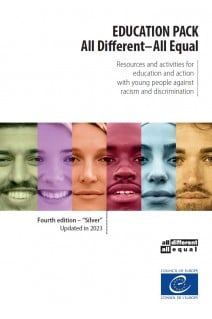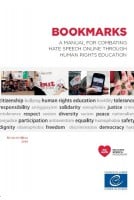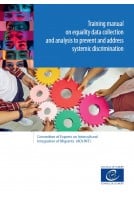An invaluable education pack proposing resources and activities for education and action with young people against racism and discrimination
It is easy to say, “I have no prejudices”, or, “I’m not racist, so it has nothing to do with me”. It is much harder to say, “I may not be to blame for what happened in the past but I want to take responsibility for making sure it doesn’t continue in the future”.
Many young people in Europe, and beyond, defied the pandemic and took to the streets in 2020 to express their sorrow and their anger in the aftermath of George Floyd’s death in Minneapolis at the hands of a white policeman. This also served as a wake-up call to the daily, systemic and sometimes structural forms of racial discrimination which are visible across Europe, expressed in hate speech or outright physical violence, and which target people on the basis of their characteristics or identity, including age, colour of skin, disability, ethnicity, gender, legal status, nationality, origin, “race”, religion and belief, sex and sexual orientation.
Youth leaders and human rights activists turned to the Council of Europe, the guardian of human rights in Europe, for responses, support and, in particular, what the youth sector could propose. A consultation with youth workers and specialists in human rights education concluded that part of the response has to be educational. The rise of populist, nationalist and xenophobic ideas and discourse must also be countered through democratic citizenship and human rights education, including anti-racism education and intercultural learning. Education remains an important antidote to racism and prejudice.
This manual was originally produced in 1995 for the European youth campaign against racism, antisemitism, xenophobia and intolerance. It has been updated and extended to
reflect the kaleidoscope of racial discrimination in Europe today and the mutations of racist discourses and ideologies. It contains basic information and hands-on non-formal education methodologies for supporting young people in learning about and addressing prejudice and its impact on people and societies.
Acknowledgements
Preface
Introduction
All Different – All Equal today
CHAPTER 1 KEY CONCEPTS AND RATIONALE FOR UNDERSTANDING AND ACTING AGAINST RACISM AND DISCRIMINATIONChallenges, problems and their origins
The challenge of “understanding” racism and discrimination
Forms and expressions of discrimination
Our responses
Legal responses: the human rights framework
The educational response
CHAPTER 2 ACTIVITES AND METHODS FOR EDUCATION AND ACTION AGAINST RACISM AND DISCRIMINATIONIntroduction to the activities Synoptic table of activities CHAPTER 3 COMBATING RACISM IN EUROPE TODAYCombating racism in Europe today
INTRODUCTION .
From All Different – All Equal to Black Lives Matter (Gavan Titley)
CONFRONTING RACISM: DENIAL AND RESISTANCE
Introduction to Part I
Our colonial pasts, our institutions today (Domenica Ghidei Biidu (European Commission Against Racism and Intolerance))
They tell us there is no racism, yet “race” is all over the pIace (Interview with Rokhaya Diallo)
An anti-racism in Europe? (Alana Lentin)
UNDERSTANDING RACISMS: CHANGE AND CONTINUITY
The shape of contemporary Islamophobia and its specific effects on young Muslims political and associative life (Hande Taner)
Border politics and queer asylum seekers (Hasti Hamidi)
ANTI-RACISMS: FUTURE YOUTH WORK RESPONSES AND DIRECTIONS
The kaleidoscope of youth-related racism, inequalities and discrimination (Barbara Giovanna Bello)
Roma youth civic and political participation in Europe* (Simona Toroțcoi)
Reclaim! Renew! Re-politicise! Making intercultural learning great again! (Yael Ohana)
About the contributors to Chapter 3






